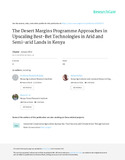The Desert Margins Programme Approaches in Upscaling Best-Bet Technologies in Arid and Semi-arid Lands in Kenya
Date
2011Author
Nyariki, Dickson M.
Esilaba, A.O.
Okoti, M.
Keya, G.A.
Miriti, J.M.
Kigomo, J.N.
Olukoye, G.
Wekesa, L.
Ego, W.
Muturi, G.M.
Metadata
Show full item recordAbstract
Kenya’s land surface is primarily arid and
AQ1
semi-aridlands(ASALs)whichaccountfor84%ofthe totallandarea.TheDesertMarginsProgramme(DMP) inKenyahasmadesomecontributiontounderstanding which technology options have potential in reducing land degradation in marginal areas and conserving biodiversity through demonstrations, testing of the most promising natural resource management options, developing sustainable alternative livelihoods and policy guidelines, and replicating successful models. In extension of sustainable natural resource management, two types of strategies were used: (i) strategies for the promotion of readily available technologies and (ii) approaches for participatory learning and action research. Thus DMP-Kenya initiated upscaling of four ‘best-bet’ technologies. Under the rangeland/livestock management options, scaling-up activities include improvement of rangeland productivity, rangeland resource management through communitybasedrangeresourcesmonitoring/assessment,andfodder conservation for home-based herds. Restoration of degraded lands included rehabilitation of rangelands using the red paint approach in conservation of Acacia tortilis, control of Prosopis, planting of Acacia senegal trees in micro-catchments, and rehabilitation of degraded areas through community enclosures. Improved land, nutrient, and water management involved upscaling water harvesting and integrated nutrient management (INM) technologies. Activities
A.O. Esilaba ( ) Desert Margins Programme, Kenya Agricultural Research Institute, Nairobi, Kenya e-mail: aoesilaba@kari.org
under tree-crop/livestock interactions included upscaling of Melia volkensii and fruit trees (mangoes) and enhancing biodiversity conservation through support of beekeeping as a viable alternative livelihood. Participatory learning and action research (PLAR) was used for technology development and dissemination. Capacity building and training was a major component of upscaling of these best-bet technologies.
URI
http://hdl.handle.net/123456789/227http://erepository.uonbi.ac.ke/handle/11295/50550
https://link.springer.com/chapter/10.1007/978-90-481-2543-2_120
https://www.academia.edu/33072218/The_Desert_Margins_Programme_Approaches_in_Upscaling_Best-Bet_Technologies_in_Arid_and_Semi-arid_Lands_in_Kenya
https://www.semanticscholar.org/paper/The-Desert-Margins-Programme-Approaches-in-Best-Bet-Esilaba-Okoti/1ce4f6d1c153ced561d5f5222279a6125b4816e2
Collections
- Journal Articles (BE) [401]

